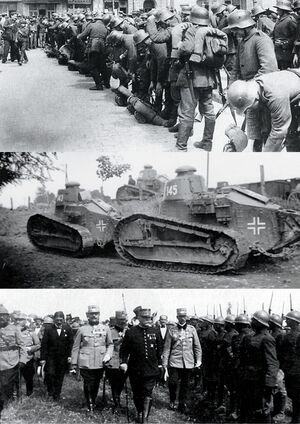War of 1919 (Pacifica)
| War of 1919 | ||||||||
|---|---|---|---|---|---|---|---|---|
 (From top to bottom) Weissersteiner forces in the city of Williemsbode; Gunter-Stein Panzerwagen in the Luxemburg Front; General Šbécke with the 2nd Corps | ||||||||
| ||||||||
| Belligerents | ||||||||
|
|
|
| ||||||
| Units involved | ||||||||
|
Imperial Weissersteiner Army
Imperial Weissersteiner Navy
Royal Clashonian Army
|
Army of the Union State
Navy of the Union State
|
1st Volunteer Corps Transclarve Volunteer Corps | ||||||
| Strength | ||||||||
|
|
|
| ||||||
The War of 1919 (Alman: Krieg von 1919, Clashonian: Krig vén 1919) was an armed conflict between the Weissersteiner Empire and the Union State of Bannarsia and Transclarvia, which lasted from 1919 to 1923. The war started over territorial dispute, namely the territories of Blubach and Bischofgen, both of which had a zinc spar mine. The war brought the end to the existence of the Union State and saw the rise of the First Clashonian Republic. The war also saw one of the earliest usage of tanks in the conflict, namely in the Northwestern Front.
Following the 1904 Clashonian coup d'etat, the Clashonian royal family, government, and military high command fled to neighboring Weisserstein, establishing the Royal Clashonian government-in-exile. Amidst the chaos of the coup, Weissersteiner forces move to secure the territories of Blubach and Bischofgen. Both territories were previously established as a condominium, but after the coup, the Weissersteiner government decided to incorporate the two territories into the Weissersteiner Empire. At the time, the Union State was unable to do anything due to their own precarious position, and the Union State was forced to recognize the annexation of the territories during discussions regarding the territories in mid-February of 1907, now known as the Brandenburg Agreement. This move angered many within the ranks of the Party of the Union State, namely its more hawkish members under the leadership of X, as well as angering many within the military, who saw both Blubach and Bischofgen as rightful Clashonian clay. The Brandenburg Agreement also gave rise to hopes of possible Transclarve secession, which culminated in the 1907 Transclarve uprising in May. The events of 1907 became a key turning point as more hawkish members of government began taking a more active role in both the military and governance, leading to X becoming the President-Minister of the Union State in 1908.
As time progressed, the Army of the Union State began drafting preparations to retake the territory since as early as 1910, citing its economic importance to the Union State. Defenses were constructed along the border with Weisserstein, namely in the areas neighboring to the Kingdom of Luxemburg. An incident in the border in 1915 nearly brought the two nations to war, but conflict was averted through diplomacy. However, the border clashes proved vital in escalating tension and sowing distrust among the two nations. The Army of the Union State began mobilizing its forces in late 1918 in preparation for the conflict, Weisserstein in return fortified its defenses in their shared border, known as the Schwarzberg Line. In the early hours of June 29, a false flag attack by Union State forces was conducted, followed by firing artillery shells on Weissersteiner positions, and on 8 AM, the Union State officially declared war on Weisserstein, citing the unjust annexation and the false flag attack on the Kleinhart Jura, as well as Weisserstein's support to the exiled Royal government, as the casus belli.